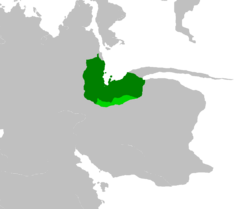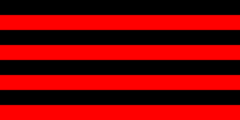Kretaza
This article is incomplete because it is pending further input from participants, or it is a work-in-progress by one author. Please comment on this article's talk page to share your input, comments and questions. Note: To contribute to this article, you may need to seek help from the author(s) of this page. |
The Great Kingdom of Kretaza | |
|---|---|
Banner of the Sejm of Kretaza
| |
 The Location of Kretaza in north-eastern Deteros, with the Cizimenean Confederacy highlighted. | |
| Capital | Kospal |
| Largest city | Deikei |
| Official languages | Katni Nizni Meikean Nizni Fendirolean |
| Ethnic groups |
|
| Religion | Nizni Bowism |
| Demonym(s) | Kretazan |
| Government | Feudal Parliamentary Republic |
| Yulakorszan of Cizimene | |
| Legislature | Sejm of Kretaza |
| Establishment | |
• Proclamation of Kretazan Kingdom | Summer 1033 |
| 1224 | |
• Monarchy abolished | Spring 1372 |
| Area | |
• Total | 829,556 km2 (320,293 sq mi) (6th) |
| Population | |
• 1386 estimate | ~11.2 million (6th) |
• Density | 34.97/km2 (90.6/sq mi) (30th) |
| Currency | Various |
Kretaza, officially the Great Kingdom of Kretaza, is a Nizni-speaking state in north-eastern Deteros. According to traditional Nizni historiography, it is considered the ninth Nizni kingdom. Originally a feudal kingdom ruled jointly by an assembly of nobles, the Sejm, and a king, it came under the full control of the Sejm in 1372. Covering an area of around 830,000 square kilometres, it is the sixth largest polity in the known world, and has an estimated population of 11.2 million.
Kretaza places itself as the ninth Kingdom in a cyclical lineage of successive 'Nizni kingdoms' existing between the Pranem and Kanget rivers, and especially the second century Kingdom of Odenko. It was established in 1033 by an alliance of powerful local landowners around the Zabou estuary during the Lords' Revolt, a rebellion against the perceived oppression and neglect of the ruling Kingdom of Vyaamen. During the revolt, these landowners elected a king to act as a military leader, making decisions in ad-hoc assemblies which would later evolve into the Sejm of Kretaza. After being established as an independent kingdom, Kretaza would steadily expand to occupy a large territory, including the subjugation of the powerful Kingdom of Fendirol. In the early thirteenth century, Kretaza would almost totally collapse, before being restored under a stronger monarchical regime by King Paskol. In 1366, relations between the monarchy of Matos IV and Sejm would deteriorate into a destructive civil war, ending the execution of Matos and end of the Kretazan monarchy in favour of direct rule by the Sejm, under a lord protector.
Kretaza has a largely agrarian economy under a largely feudal system, with a significant population of pastoralists. Forms of land tenure and taxation vary between different regions and constituent groups of the state. Kretaza's most significant export good is wool. Kretaza does not have a centralised administration or legal system, instead having an extensive and variable system of customary law.
